Solvent Tool
This tool is brought to you by the ACS GCI Pharmaceutical Roundtable (GCIPR). It is an approximate duplicate of the original tool built by AstraZeneca in Spotfire, a proprietary technology, and later donated to the ACS GCIPR. More information about the tool can be found in the original open access work below:
Toward a More Holistic Framework for Solvent Selection
Diorazio, L. J.; Hose, D. R. J.; Adlington, N. K., Org. Process Res. Dev. 2016, 20, 760-773
Version 2.0.0
Released November 2019
Solvent Selection Tool Hints and Tips
-
Introduction
This tool allows you interactively select solvents based upon the Principal Component Analysis (PCA) of the solvent’s physical properties. Solvents which are close to each other in the map have similar physical and chemical properties, whereas distance solvents are significantly different. In addition to the PCA scores other data including the physical properties, functional groups and environmental data has been included to aid in the rational selection of solvents.
-
Key Features
- 272 Solvents (research, process and next generation green solvents)
- Based upon 70 Physical Properties (30 experimental, 40 calculated)
- Properties have been selected to capture aspects of the solvent’s polarity, polarizability and hydrogen-bonding ability.
- Solvents can be selected or excluded based upon which functional groups are present (solvent compatibility)
- Impact categories included.
- Health, Impact in Air, Impact in Water and Life-Cycle Assessment.
- ICH Solvent Information (ICH class and concentration limits).
- Data relating to plant accommodation has been included.
- Auto Ignition / T_Rating, Flash Point / Flammability, Viscosity, VOC Potential, Enthalpy of Vaporization and Heat Capacity.
- Data can be exported for use in other packages for additional analysis or Design of Experiement (DoE).
This tool allows you interactively select solvents based upon the Principal Component Analysis (PCA) of the solvent’s physical properties. Solvents which are close to each other in the map have similar physical and chemical properties, whereas distance solvents are significantly different. In addition to the PCA scores other data including the physical properties, functional groups and environmental data has been included to aid in the rational selection of solvents.
Disclaimer
The American Chemical Society Green Chemistry Institute’s Pharmaceutical Roundtable (“the Roundtable”) has created this Solvent Selection Tool to inform and guide users towards greener and safer solvents for selected criteria. The Roundtable has used reasonable efforts in collecting, preparing and providing quality information and material, but does not warrant or guarantee the accuracy, completeness, adequacy or currency of the information contained in the Solvent Selection Tool. The Tool is meant to be a predictive model, but it is not conclusive; the solvent tool should be critically accessed by occupational hygienists and other experts of any institute using it. By downloading, viewing and utilizing information from the Solvent Selection Tool visitors assume full responsibility for their own actions and any damages or liabilities that may result from the utilization of information obtained from the Solvent Selection Tool. Should you have any questions or comments about the Solvent Selection Tool or this disclaimer, please send an e-mail to gcipr@acs.org.
General Hints and Tips »
Navigation
At the top of each visualization, is a set of tabs which allow you to navigate to other visualizations:

Filters
Each visualization has a set of page-specific filters. The filters may be accessed by pressing the ‘Open Filter Panel’ icon, located in the upper left corner of the visualization:

Pressing the ‘Open Filter Panel’ results in a fly-out panel, containing a set of filters. Setting any filter will impact all visualizations and the number of selected solvents. The filter fly-out panel may be closed by pressing the ‘Close Filter Panel’ icon:

![]()
In order to undo the last filter change, press the ‘Undo’ icon, located in the bottom right of the visualization:
![]()
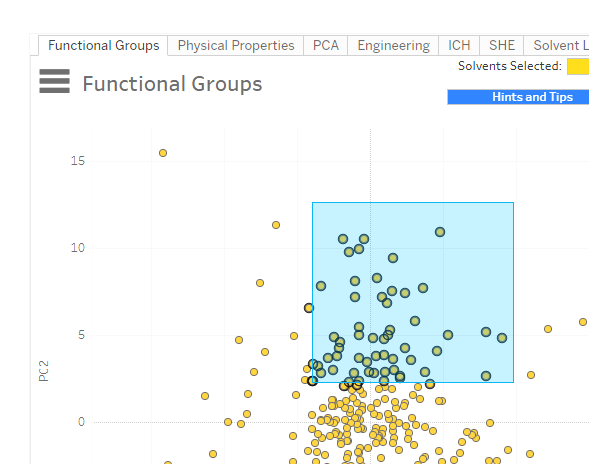
The selection can be cleared by pressing the ‘Reset’ icon, described above.
Solvent Counter
The initial set size of selected solvents is 272. As solvents are selected and/or filtered the set size decreases. The ‘Solvent Counter’ reports the number of solvents remaining in the set. The ‘Solvent Counter’ appears in the upper right corner of the visualization:
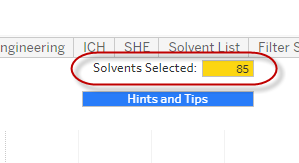
Downloading the Solvent Selection
The selected set of solvents can be downloaded into a Comma Separated Value (CSV) file at any time, using the following steps
- Press the ‘Download’ icon, in the lower right corner:

- In the pop-up menu, select ‘Data’:
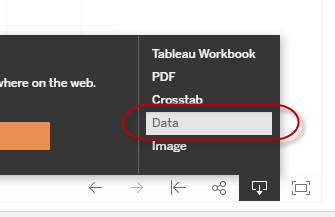
- A new web page will appear with a summary list of the solvents selected. Choose the ‘Full Data’ tab at the top of this new page:
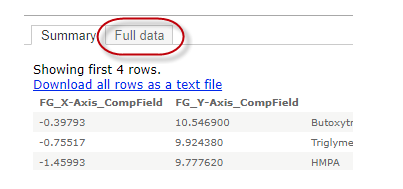
- Check the ‘Show all columns’ checkbox:
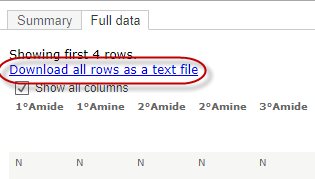
- Finally, select the link ‘Download all rows as a text file’. This will download a CSV file, each row representing a solvent in the selection.
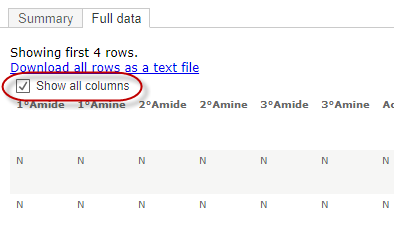
Functional Groups Hints & Tips »
- The Functional Groups visualization is used to select and deselect solvents that contain particular functional groups which may or may not be compatible with the chemistry of interest. For example, ketones would be a poor choice of solvent for reductive aminations as they would react with the amine. All of the ketones can be excluded from the list by unchecking the “y” box for ketones in the filter fly-out panel.
- Note: In order to build a stable PCA map, solvents like benzene, HMPA, etc. have been included. However, these solvents are best avoided. To exclude them, uncheck the “y” box of Avoidance to remove them.
- A text search can be run by typing a partial name of the solvent into the ‘Name’ search box.
- To select multiple solvents, click upon each solvent of interest in the ‘Name’ filter list.
See General Hints and Tips for additional information.
Physical Properties Hints & Tips »
- The filters can be used to select / deselect solvents based upon their physical properties. Most commonly, you may wish to select solvents that have a boiling point which is above a particular value (e.g. 60°C). Using the boiling point slider, or clicking upon the min/max values displayed above the slider, the minimum boiling point can be defined.
- A range of other physical properties have been included for more advanced solvent property selection.
See General Hints and Tips for additional information.
Principle Components Analysis (PCA) Hints & Tips »
- This page allows solvents to be selected based upon their PCA scores. The solvents are colored according to the PCA Quadrant and/or Octant in which they sit, including a “center point” region. This allows solvents to be selected for Design of Experiments (DoEs) based upon Quadrant/Octant. Quadrants/Octants can be removed by unchecking the required checkboxes within the filter panel.
- A text search can be run by typing a partial name of the solvent into the ‘Name’ search box.
- To select multiple solvents, click upon each solvent of interest in the ‘Name’ filter list.
See General Hints and Tips for additional information.
Engineering Hints & Tips »
- A text search can be run by typing a partial name of the solvent into the ‘Name’ search box.
- To select multiple solvents, click upon each solvent of interest in the ‘Name’ filter list.
See General Hints and Tips for additional information.
ICH Hints & Tips »
| Class 1 | Solvents that are to all practical purposes banned in the pharmaceutical manufacturing route. |
| Class 2 | Controlled to specified limits. |
| Class 3 | Essentially non-toxic. Controlled by GMP. |
| Unclassified | (No data) |
- The International Conference on Harmonisation (ICH) of Technical Requirements for Registration of Pharmaceuticals for Human Use have classified a number of solvents and specified the maximum limits that these solvent can be present in the Drug Substance. For more information see the ICH Guidelines for Residual Solvents, or discuss with the Impurities Advisory Group.
- A text search can be run by typing a partial name of the solvent into the ‘Name’ search box.
- To select multiple solvents, click upon each solvent of interest in the ‘Name’ filter list.
See General Hints and Tips for additional information.
Safety, Environment & Health (SHE) Hints & Tips »
| Green | Recommended: Solvent has limited concerns for the specific category; 1-3 on scale of 10. |
| Amber | Problematic: Solvent has some concerns which may need to be addressed; 4-6 on scale of 10. |
| Red | Hazardous: Solvent has significant issues for the specific category; 7-10 on scale of 10. | Black | Highly Hazardous: Solvent has significant overall safety, health and environmental issues that cannot be fully accounted for in the 1-10 ranking scale. |
- These rankings are derived from the Chem21 solvent selection guide rankings which cover safety, health, environment, and an adjusted ranking based on discussion. For more information please see: Prat, D.; Wells, A.; Hayler, J.; Sneddon, H.; McElroy, C. R.; Abou-Shehada, S.; Dunn, P. J. CHEM21 selection guide of classical- and less classical-solvents, Green Chem. 2016, 18, 288–296.
- For more information see the Substance Avoidance Database or the Solvent Selection Guide.
- A text search can be run by typing a partial name of the solvent into the ‘Name’ search box.
- To select multiple solvents, click upon each solvent of interest in the ‘Name’ filter list.
See General Hints and Tips for additional information.

